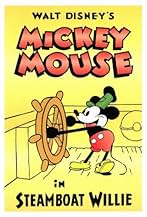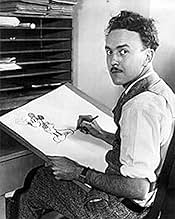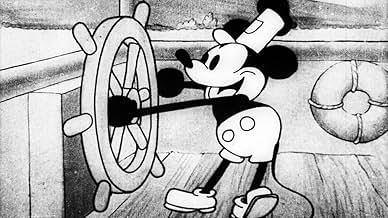AVALIAÇÃO DA IMDb
7,4/10
12 mil
SUA AVALIAÇÃO
O primeiro desenho animado lançado de Mickey Mouse e também o primeiro com som sincronizado.O primeiro desenho animado lançado de Mickey Mouse e também o primeiro com som sincronizado.O primeiro desenho animado lançado de Mickey Mouse e também o primeiro com som sincronizado.
- Direção
- Roteiristas
- Artista
- Prêmios
- 1 vitória no total
Walt Disney
- Mickey Mouse
- (narração)
- (não creditado)
- …
- Direção
- Roteiristas
- Elenco e equipe completos
- Produção, bilheteria e muito mais no IMDbPro
Avaliações em destaque
Seeing again, after a very long time, this short seems real - real creepy. So, the recent version by Nick Lives can be defined as wise one comparing with original.
Cruelty , sexism and sexual jokes, bad treatment to animals and horror in pure form.
A strange work from beginnings of Walter Disney , so funny in childhood for many from us , frighting today because the permisity about taboo themes seems just the rule.
In short, a form of revenge, reminding children sadism or teens teribilism , of Mickey against Captain Pete . And its forms are not so amusing, in fact.
But, sure, a classic. Served by a sort of a controversy answer at start of 2024 year.
Cruelty , sexism and sexual jokes, bad treatment to animals and horror in pure form.
A strange work from beginnings of Walter Disney , so funny in childhood for many from us , frighting today because the permisity about taboo themes seems just the rule.
In short, a form of revenge, reminding children sadism or teens teribilism , of Mickey against Captain Pete . And its forms are not so amusing, in fact.
But, sure, a classic. Served by a sort of a controversy answer at start of 2024 year.
A Walt Disney MICKEY MOUSE Cartoon.
STEAMBOAT WILLIE, a mischievous little rodent, neglects his pilothouse and frolics his way into cinematic history.
On 18 November 1928, a struggling young genius debuted the world's first successful cartoon with synchronous sound. There would be no looking back for either Walt Disney or his alter ego Mickey Mouse. Financial struggles would remain, but essentially the world was their oyster bed and Mickey would eventually rival Chaplin as the most recognizable cultural icon of the century.
As entertainment, STEAMBOAT WILLIE is still fun to watch, featuring fine work by animator Ub Iwerks and showing a Mickey with all the passions & indifference of a small child. He must deal with a tyrannical skipper (Pete, without his peg leg; he had been appearing in Disney cartoons since February of 1925), a wisecracking parrot (in a few years it would be a Duck) and a cute little Mouse named Minnie. Together the two rodents rather callously make music on the live bodies of a goat, cat, goose, piglets & cow (a precursor of Clarabelle) - all of whom happened to be conveniently on board the steamship. Audiences howled for more and the pattern was set for the subsequent Mouse cartoons of the next few years.
******************************
Walt Disney (1901-1966) was always intrigued by pictures & drawings. As a lad in Marceline, Missouri, he sketched farm animals on scraps of paper; later, as an ambulance driver in France during the First World War, he drew comic figures on the sides of his vehicle. Back in Kansas City, along with artist Ub Iwerks, Walt developed a primitive animation studio that provided animated commercials and tiny cartoons for the local movie theaters. Always the innovator, his ALICE IN CARTOONLAND series broke ground in placing a live figure in a cartoon universe. Business reversals sent Disney & Iwerks to Hollywood in 1923, where Walt's older brother Roy became his lifelong business manager & counselor. When a mildly successful series with Oswald The Lucky Rabbit was snatched away by the distributor, the character of Mickey Mouse sprung into Walt's imagination, ensuring Disney's immortality. The happy arrival of sound technology made Mickey's screen debut, STEAMBOAT WILLIE (1928), a tremendous audience success with its use of synchronized music. The SILLY SYMPHONIES soon appeared, and Walt's growing crew of marvelously talented animators were quickly conquering new territory with full color, illusions of depth and radical advancements in personality development, an arena in which Walt's genius was unbeatable. Mickey's feisty, naughty behavior had captured millions of fans, but he was soon to be joined by other animated companions: temperamental Donald Duck, intellectually-challenged Goofy and energetic Pluto. All this was in preparation for Walt's grandest dream - feature length animated films. Against a blizzard of doomsayers, Walt persevered and over the next decades delighted children of all ages with the adventures of Snow White, Pinocchio, Dumbo, Bambi & Peter Pan. Walt never forgot that his fortunes were all started by a mouse, or that childlike simplicity of message and lots of hard work always pay off.
STEAMBOAT WILLIE, a mischievous little rodent, neglects his pilothouse and frolics his way into cinematic history.
On 18 November 1928, a struggling young genius debuted the world's first successful cartoon with synchronous sound. There would be no looking back for either Walt Disney or his alter ego Mickey Mouse. Financial struggles would remain, but essentially the world was their oyster bed and Mickey would eventually rival Chaplin as the most recognizable cultural icon of the century.
As entertainment, STEAMBOAT WILLIE is still fun to watch, featuring fine work by animator Ub Iwerks and showing a Mickey with all the passions & indifference of a small child. He must deal with a tyrannical skipper (Pete, without his peg leg; he had been appearing in Disney cartoons since February of 1925), a wisecracking parrot (in a few years it would be a Duck) and a cute little Mouse named Minnie. Together the two rodents rather callously make music on the live bodies of a goat, cat, goose, piglets & cow (a precursor of Clarabelle) - all of whom happened to be conveniently on board the steamship. Audiences howled for more and the pattern was set for the subsequent Mouse cartoons of the next few years.
******************************
Walt Disney (1901-1966) was always intrigued by pictures & drawings. As a lad in Marceline, Missouri, he sketched farm animals on scraps of paper; later, as an ambulance driver in France during the First World War, he drew comic figures on the sides of his vehicle. Back in Kansas City, along with artist Ub Iwerks, Walt developed a primitive animation studio that provided animated commercials and tiny cartoons for the local movie theaters. Always the innovator, his ALICE IN CARTOONLAND series broke ground in placing a live figure in a cartoon universe. Business reversals sent Disney & Iwerks to Hollywood in 1923, where Walt's older brother Roy became his lifelong business manager & counselor. When a mildly successful series with Oswald The Lucky Rabbit was snatched away by the distributor, the character of Mickey Mouse sprung into Walt's imagination, ensuring Disney's immortality. The happy arrival of sound technology made Mickey's screen debut, STEAMBOAT WILLIE (1928), a tremendous audience success with its use of synchronized music. The SILLY SYMPHONIES soon appeared, and Walt's growing crew of marvelously talented animators were quickly conquering new territory with full color, illusions of depth and radical advancements in personality development, an arena in which Walt's genius was unbeatable. Mickey's feisty, naughty behavior had captured millions of fans, but he was soon to be joined by other animated companions: temperamental Donald Duck, intellectually-challenged Goofy and energetic Pluto. All this was in preparation for Walt's grandest dream - feature length animated films. Against a blizzard of doomsayers, Walt persevered and over the next decades delighted children of all ages with the adventures of Snow White, Pinocchio, Dumbo, Bambi & Peter Pan. Walt never forgot that his fortunes were all started by a mouse, or that childlike simplicity of message and lots of hard work always pay off.
... the end of Buster Keaton's career? This cartoon was released at the end of 1928, eight months after the release of Buster Keaton's final independent film - Steamboat Bill, Jr. Why should somebody shell out money for Keaton to take a chance with life and limb with his wonderful acrobatics when Walt could draw a mouse that could do all of those antics, not show up late to the set, not require lunch breaks, and come back for the next film/cartoon fresh as a daisy and uninjured?
I don't know if the similarity between the title of this cartoon and Buster's last independent creation is anything but coincidence, but I wonder. Always worth a look to see the wonderfully creative Walt at work in the beginning. He would shake his head at what his company is outputting as product today. But I digress.
Highly recommended for the film history angle.
I don't know if the similarity between the title of this cartoon and Buster's last independent creation is anything but coincidence, but I wonder. Always worth a look to see the wonderfully creative Walt at work in the beginning. He would shake his head at what his company is outputting as product today. But I digress.
Highly recommended for the film history angle.
This era was not just the dawn of sound in cartoons, but of a cartoon character which would go down in history as the world's most famous mouse. Yes, Mickey makes his debut here, in this cheery tale of life on board a steamboat. The animation is good for it's time, and the plot - though a little simple - is quite jolly. A true classic, and if you ever manage to get it on video, you won't regret it.
This 8 minute gem is not only timeless, but it is a cartoon milestone. It is Mickey's third cartoon, and one of his best ones too. It is a cartoon milestone because it was the first one with synchronised sound. And my goodness, even after 70+ years it is ever so good, and gives real additional weight to the narrative. The black and white animation is excellent, and the character features are convincing enough. The music is wonderful, I love the soundtrack, it does add to the fun the cartoon has, no matter how thin the story sometimes is. And the cartoon is funny! So many memorable moments, like the cow's teeth being used as an xylophone and its udder as a bagpipe. The characters are also engaging, Mickey and Minnie two landmark Disney characters are well voiced by Walt Disney, and Pete serves well as "the villain of the piece". All in all, "Steamboat Willie" is just a timeless gem that everybody should see at least once. 10/10 Bethany Cox
Você sabia?
- CuriosidadesBefore the copyright for the cartoon was set to expire in 2003, Disney lobbied the US Congress successfully for an extension of copyright protection by 20 years. It officially entered the public domain on January 1, 2024.
- Erros de gravaçãoAt the Podunk Landing site, the cow's tag around her neck disappears for a second when she moos and is back again.
- Versões alternativasAfter Mickey pulls nursing piglets in tune to music, he removes them and plays on their mother's teats like an accordion. This scene has been deleted for Mickey's 25th Anniversary theatrical release in 1953.
- ConexõesEdited into The Mickey Mouse Anniversary Show (1968)
Principais escolhas
Faça login para avaliar e ver a lista de recomendações personalizadas
Detalhes
- Data de lançamento
- País de origem
- Central de atendimento oficial
- Idioma
- Também conhecido como
- Steamboat Willie
- Empresa de produção
- Consulte mais créditos da empresa na IMDbPro
Bilheteria
- Orçamento
- US$ 4.986 (estimativa)
- Tempo de duração8 minutos
- Cor
- Mixagem de som
- Proporção
- 1.33 : 1
Contribua para esta página
Sugerir uma alteração ou adicionar conteúdo ausente

Principal brecha
By what name was O Vapor Willie (1928) officially released in India in English?
Responda




















